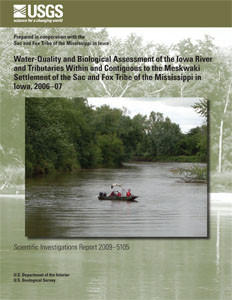
Product Details
- Product Number
- 209299
- Series
- SIR-2009-5105
- Scale
- NO SCALE
- Alternate ID
- SIR2009-5105
- ISBN
- 978-1-4113-2434-3
- Authors
- GREGORY R LITTIN
- Version Date
- 01/01/2009
- Regions
- IA
- Countries
- USA
- Media
- Paper
- Format
- Bound
Additional Details
- Description
- 7/15/2009 Abstract In cooperation with the Sac and Fox Tribe of the Mississippi in Iowa (Meskwaki Nation), the U.S. Geological Survey conducted a 2-year baseline assessment of the chemical and biological quality of streams within the Meskwaki Settlement in central Iowa. The Meskwaki Nation is a federally recognized tribe that wishes to establish water-quality standards to safeguard the integrity of surface waters and aquatic biota within the settlement for the health and welfare of the tribal community. The settlement is drained by the Iowa River and four tributaries (Onion, Cattail, Raven, and Bennett Creeks). Water-quality samples were collected at three sites on the Iowa River, two sites on Onion Creek, and one site each on Cattail, Raven, and Bennett Creeks from April 2006 through July 2007. Biological and habitat assessments were conducted at all three sites on the Iowa River and the downstream- most site on Onion Creek from June through August 2007. Analysis of physical properties, major ions, nutrients, trace compounds, bacteria, and total suspended solids in water, and trace metals and organic compounds in streambed sediment provided information about the effects of anthropogenic (human related) activities on the water quality of settlement streams. Analysis of biological samples collected during the summer of 2007, including fish community, benthic macroinvertebrates, and periphyton samples, as well as physical habitat characteristics, provided information on the effects of water quality on the condition of the aquatic environment. The majority of surface water sampled within the settlement was predominately a calcium bicarbonate type. Nitrates (nitrate plus nitrite as nitrogen) exceeded the U.S. Environmental Protection Agency's (USEPA) primary drinking-water Maximum Contaminant Level of 10 ug/L in 19 of 36 samples from sites on the Iowa River and Raven and Bennett Creeks but not in samples from Onion and Cattail Creeks. None of the samples analyzed for pesticides, trace metals, wastewater, or fuel contaminants were found to exceed drinking-water regulations for the USEPA or State of Iowa targeted constituents. Bacteria densities for Escherichia coli (E. coli) ranged from less than 10 to more than 600,000 colony-forming units per 100 milliliters of water and were largest following intense rainfall runoff. The largest densities were recorded in samples collected from the tributaries, most notably from Cattail Creek downstream from the tribal headquarters area and Onion Creek downstream from the sewage lagoons. Arsenic and nickel concentrations in bottom sediment from Onion Creek exceeded the USEPA threshold effects level in a composite sample collected during the habitat assessment in July 2007. Suspended-sediment concentration was estimated in terms of total suspended solids. Overall, Onion and Bennett Creeks were the least turbid, whereas the ephemeral Cattail Creek had the most turbid samples. Aquatic-community data were collected at four sites on the Meskwaki Settlement during the summer of 2007 to provide a baseline biological assessment of stream conditions. This assessment was based on sampling of the fish, benthic macroinvertebrate, and periphyton communities along with physical habitat characteristics. Individual biological metrics were derived from the data collected during the community surveys. These metrics were used to calculate Indexes of Biological Integrity (IBIs). The calculated values from the IBIs provided a numerical value that was used to provide an assessment of the biological condition at each biological sampling site. The fish community samples indicated that all of the sampling sites would be considered in fair condition, with one exception being a collection site on the Iowa River at Highway 49 near Tama, Iowa, which was classified in poor condition. The benthic macroinvertebrate IBI indicated a classification of good for three of the four biological sampling sites, with the Iowa River near Montour, Iowa, site classified as fair. The periphyton community assessment indicated that the potential for eutrophic conditions exists on the basis of the species that are present in the streams at all of the biological sampling sites. The physical in- stream habitat and proximate-riparian habitat indicate that the Iowa River sites are in fair condition and that the Onion Creek site is in poor condition. A cause for this difference in classification would be that the Onion Creek site has had greater effects from anthropogenic sources. Fish-tissue samples, both fillet and liver, were collected to provide an assessment of current fish health and the potential effects on human health related to the contaminants present in fish tissue. Both cadmium and mercury were found in liver samples at concentrations that would warrant fish-consumption advisories. The insecticide dieldrin was also detected at all sites in both the fillet and liver samples at concentrations greater than USEPA risk-based screening values. A few organic wastewater contaminants also were found in fish-tissue samples; a class of chemicals known as polybrominated dephenyl ethers (PBDEs), a flame retardant, was found at all four sites in both fillet and liver samples. Other organic wastewater contaminants found in the whole fish samples from the Onion Creek site were triclosan, an antimicrobial disinfectant, and its degradate methoxytriclosan. The fish-tissue sample results indicated the need for further study of contamination levels and potential health effects so that effective fish-consumption advisory levels can be developed for the Meskwaki Settlement.
- Height In Inches
- 11.000
- Width In Inches
- 0.200
- Length In Inches
- 8.500
- Two Sided
- Yes
- Pieces
- 1
- Languages
- English
Related Items





